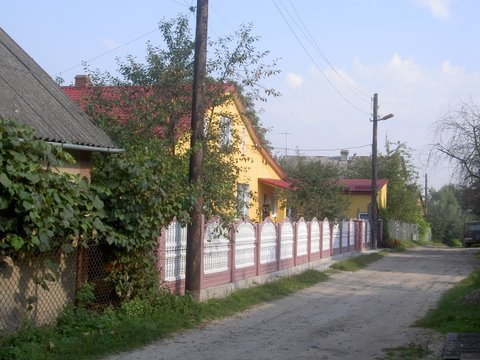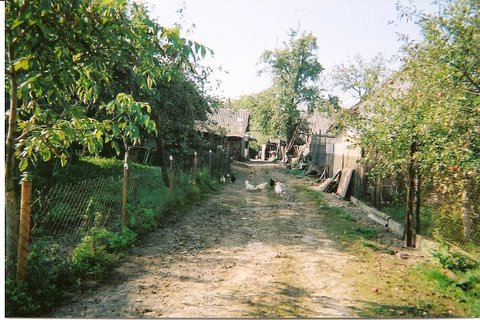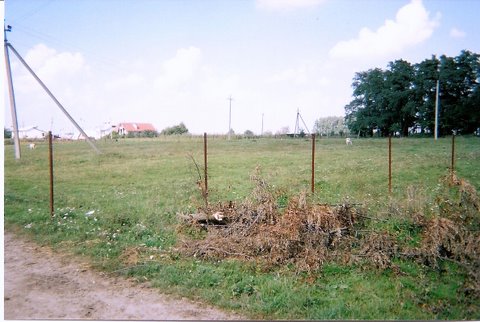KAMENKA-BUGSKAYA-I: US Commission No. UA13590101
Alternative names: German: Kamenka Strumibova, Polish: Kamienka Strumilowa, Other: Domoszyn (14th century). It is located in Lvovskaya oblast at 50º06' and 42º00', 45-km from Lvov. The cemetery is located in the center of the village, corner of Richna and Nesalezhnosti streets. Present town population is 5000-25000 with less than 10 Jews.
-- Town officials: town soviet chairman Sukhovich Evgeniy Ivanovich, tel.: 51516; Deputy Chairman Lyc Yaroslav Mikhailovich, tel.: 51840; Deputy Chairman Vladyka Mikhail, tel.: 51508. Town soviet and executive committee of Kamenka-Bugskaya, Shevchnko St., 2.
-- Regional officials: Lvov Regional State Administration, Lvov Vinnichenko St., 18, reception room, tel.: 722947, 728093. Lvov Center State Historical Archives (CSHA), Sobornaya square, 3a, tel.: 723508.
-- Authority: Lvov Jewish Community, Lvov Mikhnovskih St., 4, Rabbi Mordekhai Shloime Bold, tel.: 330524.
The unlocked cemetery has no caretaker.
The earliest mention of Jewish community is 1589. 1900 Jewish population was 3164. Effecting Jewish community: agreement between Christians and Jews in 1589; permission for synagogue building on 24 July 1627; execution of Rabbi Khaim Raitses in 1728; and Ukrainian-Polish war (1648-1654). Rabbi Khaim Raitses (died in 1728), Rabbi Samson Vainer (1808), chairman of Bet Din, lived here. The unlandmarked Orthodox (Belski Hasidic) cemetery was created in 1633. The isolated urban plain has no sign or marker. Reached by turning directly off road, access is open to all. No wall, fence or or gate. The approximate size of the cemetery before the World War II was 1,35 hectares. No complete stones are visible. More than 75% of stones are broken. Some removed sandstone gravestones are part of roads or structures; other are in storage of municipal economy. Municipality owns property that contains cinema, resident houses, park, and monument to A. Pushkin. The cemetery borders residential area. The cemetery boundaries are smaller than in 1939 because of the housing development and new roads and highways. Rarely, private visitors stop here. The cemetery was vandalized during the World War II. Within the cemetery are cinema, resident houses, and residences. The cemetery was demolished during the World War II so no threats.
Gelston visited site on 2.10.1998. Kats German Angelevich, Kamenka-Bugskaya, Strumila St. (former Matrosov St.) 2, tel.: 51862 were interviewed. Gelston completed survey on 5.10.98. Documentation: CSHA, Fond 186, Inventory 6, 439 Points of Safe. Jewish Encyclopedia , B.9, p.197, St Petersburg, 1909; Slownik Geograficzny Krolewstwa Polskiego., T.3, St 782, Warszawa, 1882 (in Polish); B. Folinski Zrodla Dziejowe Starowstwa, Kamionki Strymilowej, T.1, Kam. Strym., 1928 (in Polish).
KAMENKA-BUGSKAYA-II: US Commission No. UA13590102
Another possible information source is Kats German Angelevich, Strumila Street (former-Matrosov St.) 2, tel.: 51862. The cemetery is located at the southeast part of the village, in front of railway station, Shevchenko St. 55-57. The cemetery was created in 1633 with last known Jewish burial in 1930s. Orthodox (Hasidic) community used this unlandmarked cemetery. The isolated suburban plain has no sign or marker. Reached by turning directly off the road and crossing private residence development, access is open with permission. Metal fence and gate without lock surround the cemetery. There are no complete gravestones; and more than 75% of stones are broken. Location of any removed stones is unknown. The cemetery contains no mass graves. A private person owns property used as housing development. The cemetery borders a residential area. The cemetery boundaries are smaller than in 1939 because of the housing development. Rarely, private visitors stop here. The cemetery was vandalized during the World War II and since. There has been no care or restoration. Within the cemetery are private houses. Gravestones were broken during German occupation as well as post-War period. Tombstones were used as building material. Building on cemetery land is occurring now.
Iosif Gelston, Lvov, 290049, PO Box 10569, tel./fax: (0322) 227490 completed survey on 4.10.1998. Gelston visited site on 2.10.1998. Kats German Angelevich, Strumila St. (formerly Matrosov St.), 2, tel.: 51862 was interviewed. Documentation: Jewish Encyclopedia , B.9, p.197, St Petersburg, 1909; Slownik Gegraficzny Krolewstwa Polskiego, T.3, St 782, Warszawa, 1882 (in Polish); B.Falinski "Zrodka Dziejowe Starostwa, Kamionki Strumilowej", T.1, Kam. St, 1928 (in Polish); Basic plan of Kamenka-Bugskaya, scale 1:5000, 1961.
Photos taken in Sept. 2006 were contributed by This email address is being protected from spambots. You need JavaScript enabled to view it., Portage, MI [August 2009] - "Homes were built atop the cemetery."
KAMENKA-BUGSKAYA-III: US Commission No. UA13590103The cemetery is located at the southeast part of the village, Shevchenko St., 131, a mixed fodder factory. The cemetery was created in the first half of the 20th century. The last known Orthodox (Hasidic) Jewish burial was in 1930s. The unlandmarked, isolated suburban plain has no sign or marker. Reached by crossing mixed fodder factory area, access is completely closed. A continuous fence and gate with lock surround site. The approximate size of the cemetery before the World War II was 0.24 hectares. There are no visible gravestones. More than 75% of stones are broken. The cemetery contains no mass graves. Municipality owns property used for agricultural and mixed fodder factory. The cemetery borders agricultural and residential areas. The cemetery boundaries are smaller than in 1939 because of the commercial-industrial development. The cemetery is visited rarely. The cemetery was vandalized during the World War II, between 1945 and 1981, but not during last 10 years. There has been no care or restoration. Within the cemetery there are industrial structures. The cemetery and gravestones were demolished after 1961, when the still-active mixed fodder factory was built.
Kats German Angelevich, Strumila St. (ex-Matrosov St.), 2, tel.: 51862, was interviewed. Iosif Gelston, Lvov, 290049, PO Box 10569, tel./fax: (0322) 227490 completed survey on 4.10.1998. He visited site on 2.10.1998. Documentation: Jewish Encyclopedia , B.9, p.197, St Petersburg, 1909; Slownik Gegraficzny Krolewstwa Polskiego, T.3, St 782, Warszawa, 1882 (in Polish); B.Falinski "Zrodka Dziejowe Starostwa, Kamionki Strumilowej", T.1, Kam. St, 1928 (in Polish). Basic plan of Kamenka-Bugskaya, scale 1:5000, 1961.
KAMENKA-BUGSKAYA IV: US Commission No. UA13590501
The mass burial site is located at the east part of the village, Selskogospodarskaya St. in flax factory area. Another possible information source is Kats German Angelevich, Kamenka Bugskaya Strumila St. (formerly Matrosova St.) 2, tel.: 51862. The unlandmarked mass gravesite was dug in September 1942 for Orthodox (Hasidic) community. The isolated suburban plain has no sign or marker. Reached by turning directly off road, access is open to all. No walls, fence, or gate surrounds. No tombstones are visible but the site contains unmarked mass graves. Municipality owns property used for industrial or commercial usage and as storage. The cemetery borders residential area and tillage field. Rarely, private visitors stop here. The cemetery has never been vandalized. Within the cemetery are no structures. On site of Jewish mass execution is a flax factory. 3000Jews were murdered September 1, 1942. According to the story that told the old citizen German Angelevich Kats, Ukrainians carried out the execution under the orders of German authorities.
Iosif Gelston, Lvov, 290049, PO Box 10569, tel./fax: (0322) 227490 completed survey on 5.10.1998. Documentation: basic plan of "Giprograd" institute of Kamenka-Strumilov, scale 1:5000, 1961. Iosf Gelston visited the site for this survey in 2.10.1998. Kats German Angelevich, Kamenka Bugskaya, Strumila St. (former Matrosova St.), 2, tel.: 51862, was interviewed.
Photo taken in Sept. 2006 was contributed by This email address is being protected from spambots. You need JavaScript enabled to view it., Portage, MI [August 2009] - "That is a tethered goat grazing atop the mass grave."



